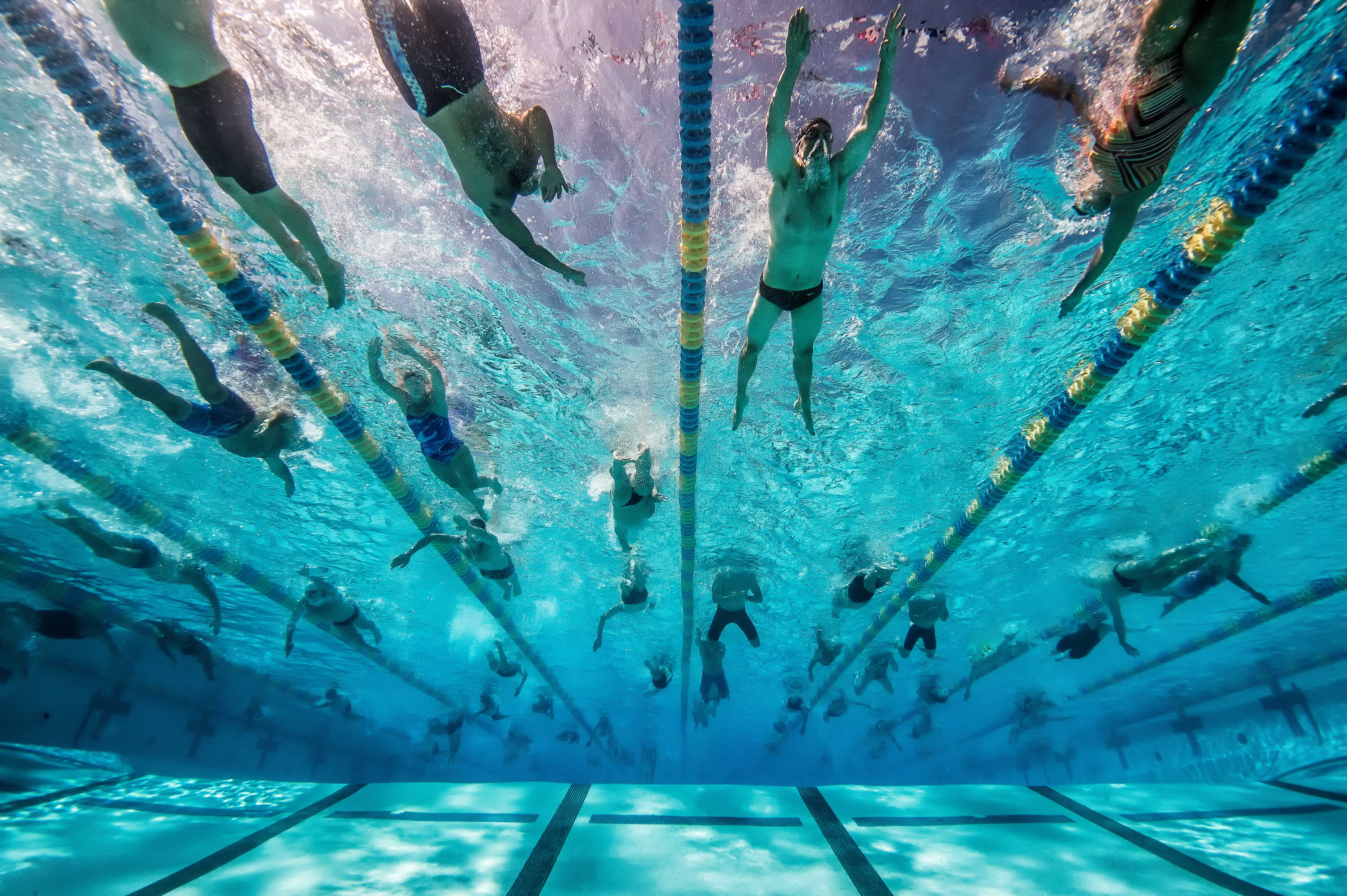Dryland Training for Swimmers

There are certain aspects of a swimmer’s body that have negative effects for athletes on land. Competitive swimming can lead to poor posture, hyperextension, inability to absorb shock, loose ankles, and over or under-developed muscle groups. Check out this article to learn more about the five most common idiosyncrasies aquatic athletes face. Strength and dryland training for swimmers can mitigate the negative effects of these issues.
Posture (rounded shoulders and curved back)
A proper standing posture reveals a gentle curve in the spine, resembling a slight “S” shape. For many dryland exercises, such as squatting, dead lifts, and other closed kinetic chain* movements, the athlete’s upper back must be flat while the lower back may have a slight curve. This position protects the lower back from bearing excessive weight and transfers the force from the lower limbs through the trunk efficiently. A kyphotic back during lifting or bodyweight exercises means that the core is either too weak or not engaged when it should be contracted, and the spine is bearing load in inappropriate areas. Specific exercises in dryland training for swimmers help correct kyphosis and develop good habits. Athletes should incorporate rehabilitation exercises to reinforce the correct movement pattern before they start lifting. Dryland training for swimmers should also integrate core training to ensure those muscles are developed and engaged during other exercises to support the lower back.
Hyperextension (Elbows, Knees)
Dryland training for swimmers involves loaded strength training. As a general rule, athletes should avoid “locking” one’s legs or arms during strength exercises because this puts the limb in a compromised position if the joint cannot unlock quickly. Although an unlocked limb will feel odd to athletes with hyperextension, it will maintain the proper technique of the exercise. In fact, a very slight bend in the limb (decreasing the joint angle) is preferable for injury prevention. Should the load be too intense, the limb can then bend in its natural direction to distribute the force. However, hyperextension is an innate characteristic of some swimmers that cannot be altered through any exercises. Rather, the athlete must learn to be careful in strength training by not fully extending the legs and arms during a movement. Avoiding a locked position, especially when it involves hyperextension, ensures that the right muscles are engaged and working to produce the movement.
Quadriceps Dominance
Swimmers with habitually tight quadriceps may resort to improper lifting technique and place more strain on surrounding joints such as the hip capsule and knees. For example, a squat that solely activates the quadriceps will allow the knees to track inward toward the body midline, putting the ACL (anterior cruciate ligament) in a dangerous position where it is prone to tearing. This occurs because the gluteus maximus and gluteus medius are not activated to resist the inward movement of the knee. Swimmers will remain quad dominant, but they can integrate exercises to activate other muscle groups as a form of injury prevention. They must start with basic activation, slowly moving through an exercise while training the brain to contract all the appropriate muscles. Over time, the muscle recruitment will become automatic, re-establishing co-contraction and helping athletes properly develop.
Shock Absorbance
Dryland training for swimmers can help athletes maintain bone density. In order to be better at shock absorbance, swimmers should focus on landing from jumps “quietly”, meaning their feet land lightly. This requires greater body control in the legs and core to control their landing. Dryland strength programs should include jumping because the explosive strength development can translate well to diving and flipturns. Start with smaller jumps (lower boxes if box jumping) and get an athlete's technique down before moving on to higher jumps. On the other hand, swimmers should avoid running because it unnecessarily puts the athlete at risk of injury.
Loose Ankles
Having good proprioception, or awareness of one’s body in the surrounding space, can help prevent ankle injuries. Other ways to minimize rolled ankles are to strengthen the surrounding musculature and to improve balance. Working on balance will not only help athletes stabilize themselves from falling, but it will also improve a swimmer's body position in the water by forcing them to engage their core. Body awareness is a means to prevent injury and to improve biomechanics.
Recap
Dryland training for swimmers and working hard in the weight room can be the difference between sitting on the sidelines with an injury or competing in the pool. To learn more about preparing for a championship swimming season check out this article.
About the Author

At Bridge, we are all athletes and coaches first. As athletes, our team has experienced everything from riding the pine on JV, to winning NCAA championships, to competing in the Olympic Games. As coaches, we have helped countless athletes reach their full potential, winning everything from age group section championships to Olympic Gold Medals.
Related Posts

The Best Bench Press Variation You’re...
This post is part of our Coaches Corner series with Taylor Rimmer. Taylor is NSCA-CPT, StrongFirst...

Does Powerlifting Harm Heart Health?
A recent study has discovered that a 12-week supervised strength training program (SSTP) may result...
-1.png)
Barefoot Running: Is It For You? |...
Run Free: Consider Less Cushion
Updated October 2020:
With more athletes looking for ways to...


